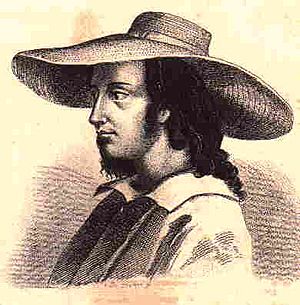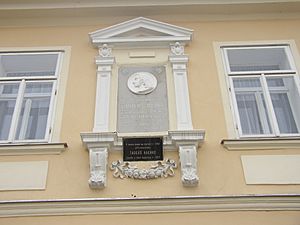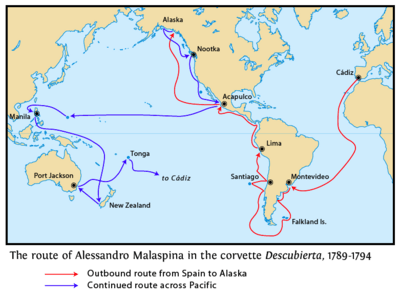Thaddäus Haenke facts for kids
Thaddeus Xaverius Peregrinus Haenke (born October 5, 1761 – died November 4, 1816) was a brilliant botanist and explorer. He was part of the important Malaspina Expedition, a big journey that explored a large part of the Pacific Ocean. This included the coasts of North and South America, Australia, the Philippines, New Zealand, and the Mariana Islands. Haenke collected many plant samples, which helped scientists describe new plants from these areas, especially South America and the Philippines. Because of his amazing work with plants and his wide travels, some people called him the "Bohemian Humboldt". This is a comparison to another famous explorer, Alexander von Humboldt, who even used some of Haenke's discoveries before his own trip to the Americas.
Contents
Who Was Thaddeus Haenke?
Thaddeus Haenke was born on October 5, 1761, in a village called Kreibitz, which was in Bohemia. Today, this place is known as Chřibská in the Czech Republic. His parents were Sudeten Germans. His father, Elias George Thomas Haenke, was a successful lawyer and farmer who also served as the mayor of their town.
From a young age, Thaddeus loved observing nature. He continued this interest throughout his education. He studied natural science and philosophy at the University of Prague. His main teacher there was Joseph Gottfried Mikan, a professor who taught about plants. Haenke worked as Mikan's assistant, helping to take care of the university's botanic gardens. He earned his doctorate degree in 1782. He kept studying in Prague until 1786, then moved to the University of Vienna. There, he studied medicine and botany with another famous botanist, Nikolaus Joseph von Jacquin.
Even while he was still a student, Haenke collected many plants from what is now the Czech Republic. He also wrote a detailed paper about the plants of the Giant Mountains. He helped edit a new version of a famous book by Linnaeus called Genera Plantarum, which was published in 1791. For his hard work, he received a silver medal from the Royal Czech Scientific Society. Besides his science, Haenke was also a talented musician, a good artist, and he could speak five different languages!
The Malaspina Expedition: A Big Adventure
By 1789, Thaddeus Haenke was a well-known young scientist. When Spain was looking for scientists for the Malaspina expedition, his teachers Jacquin and Ignaz von Born suggested his name. Even Emperor Joseph II knew Haenke and approved his joining the expedition. So, Haenke became the "Naturalist-Botanist for His Majesty" for this important journey.
Haenke had a long trip from Vienna to reach Cadiz, Spain. He arrived on July 30, 1789, just a few hours after the two expedition ships, the Descubierta and Atrevida, had already sailed away!
Determined not to miss this amazing chance, he quickly found another ship. He planned to catch up with the expedition in Montevideo. However, his ship was shipwrecked near his destination. Haenke had to swim to shore, saving only his equipment for collecting plants and his copy of Genera Plantarum. Again, he had just missed the expedition!
After resting in Buenos Aires, he hired guides for a long journey overland. They crossed the wide grasslands called pampas and the tall Andes mountains. He hoped to meet the expedition in Valparaiso. Along the way, Haenke managed to collect about 1,400 plants. Many of these were completely new to science! Even though his plant collecting must have made them slower, he reached the coast in time to join Malaspina in April 1790.
From that point, Haenke stayed with the expedition for the next three years. He collected plants and wrote down his observations about botany (plants), zoology (animals), geology (rocks and earth), and ethnology (human cultures). They first traveled up the west coast of the Americas, going as far as Alaska. Then, they returned south to Acapulco and crossed the Pacific Ocean. They explored the Philippines, Australia, and New Zealand. At each place they stopped, Haenke focused on studying plants, with different results.
In Yakutat Bay, Alaska, the plants he found were very similar to those in Europe, which was a bit disappointing. So, he focused instead on the local Indian culture, especially their music. In Nootka Sound, he made the first scientific collection of plants ever found in Canada. Their short visit to California allowed Haenke to collect and list over 250 different plant species. Most notably, he was the first scientist to collect the seeds and samples of the giant coast redwood trees.
After crossing the Pacific, Haenke collected thousands of plants during their seven-month stay in the Philippines. He also collected more plants in Australia, New Zealand, and Tonga. In the summer of 1793, the expedition returned to Peru. There, Malaspina received orders to go back home by way of Montevideo. Haenke was allowed to leave the ship with an assistant. He planned to cross overland to Buenos Aires, doing more botanical and scientific work along the way. However, instead of rejoining the fleet in the fall of 1794 as planned, Haenke became completely fascinated by the local plants. He decided to settle in Cochabamba, Bolivia, to continue his scientific studies.
For the next 25 years, Haenke continued exploring the plants of Bolivia, Peru, and Brazil. In 1801, he made one of his most amazing discoveries: the giant water lily, Victoria amazonica. This incredible plant has lily pads that can be six feet wide! Besides his plant studies, Haenke also had his own botanic garden. He owned a silver mine and worked as the local doctor in his new home town, Cochabamba. He is also given credit for starting the production of saltpeter (a chemical used in fertilizers and explosives) in Chile. He also helped to start the glass industry there.
Haenke had always hoped to return to Europe. Sadly, he died unexpectedly in 1816 when he was accidentally poisoned by his maid.
Haenke's Lasting Impact
When Malaspina returned from his voyage, he got into an argument with Spain's minister, Manuel de Godoy. Because of this, Malaspina was put in prison for seven years. As a result, the official report of the expedition was not published for almost a century. Many of the expedition's findings and reports were never shared with the public.
Haenke's huge collection of over 15,000 plant samples was found in Cadiz after he died. In 1821, the Czech National Museum bought them and moved them to Prague. A Czech botanist named Carl Bořivoj Presl spent nearly 15 years working on a book called "Reliquiae Haenkeanae" (published from 1825 to 1835). This book was based on Haenke's plant samples from the Americas and the Philippines. Six volumes were created, but the work was never fully finished because there wasn't enough money.
- Presl, Carl Bořivoj. Reliquiae Haenkeanae: seu descriptiones et icones plantarum, quas in America meridionali et boreali, in insulis Philippinis et Marianis collegit Thaddaeus Haenke. J.G. Calve, Prague, 1830.
- Presl, Carl Bořivoj. Reliquiae Haenkeanae volume I
Haenke Island and Haenke Glacier in Alaska are named in his honor. There is also a small private museum, "Muzeum Tadeáše Haenkeho", at Haenke's birth home in Chřibská, Czech Republic.
About 240 different types of plants and animals have been named after him. Some examples include:
- Alpinia haenkei C.Presl
- Berberis haenkeana Presl ex Schult. f.
- Bromus haenkeanus (J.Presl) Kunth,
- Carex haenkeana C.Presl
- Ceratochloa haenkeana J.Presl
- Hymenoxys haenkeana DC.
- Leptosolena haenkei C.Presl
- Lobelia haenkeana A.DC.
- Loranthus haenkeanus Presl ex Schult.f.
- Mascagnia haenkeana W.R.Anderson
- Pseudogynoxys haenkei (DC.) Cabrera
- Pteris haenkeana C.Presl
- Salvia haenkei Benth.
- Schinopsis haenkeana Engl.
- Waltheria haenkeana D.Dietr.
See also
 In Spanish: Thaddeus Peregrinus Haenke para niños
In Spanish: Thaddeus Peregrinus Haenke para niños
- European and American voyages of scientific exploration





